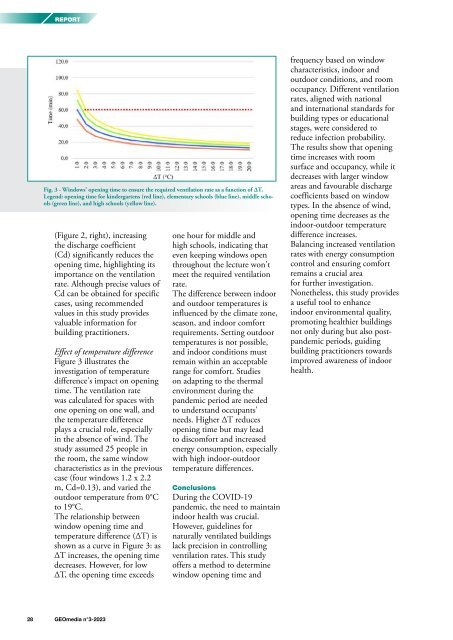GEOmedia_3_2023
EUMAP During the recent pandemic period, the world's attention has shifted towards the healthcare sector, with world leaders striving to avoid the collapse of their national healthcare systems; the economy has entered an artificial coma, while utility systems, including energy, water, telecommunications and waste management systems, have been asked to act immediately in response to these unprecedented conditions, placing extreme pressure on public utility systems.
EUMAP
During the recent pandemic period, the world's attention has shifted towards the healthcare sector, with world leaders striving to avoid the collapse of their national healthcare systems; the economy has entered an artificial coma, while utility systems, including energy, water, telecommunications and waste management systems, have been asked to act immediately in response to these unprecedented conditions, placing extreme pressure on public utility systems.
Create successful ePaper yourself
Turn your PDF publications into a flip-book with our unique Google optimized e-Paper software.
REPORT<br />
Fig. 3 - Windows’ opening time to ensure the required ventilation rate as a function of ΔT.<br />
Legend: opening time for kindergartens (red line), elementary schools (blue line), middle schools<br />
(green line), and high schools (yellow line).<br />
(Figure 2, right), increasing<br />
the discharge coefficient<br />
(Cd) significantly reduces the<br />
opening time, highlighting its<br />
importance on the ventilation<br />
rate. Although precise values of<br />
Cd can be obtained for specific<br />
cases, using recommended<br />
values in this study provides<br />
valuable information for<br />
building practitioners.<br />
Effect of temperature difference<br />
Figure 3 illustrates the<br />
investigation of temperature<br />
difference's impact on opening<br />
time. The ventilation rate<br />
was calculated for spaces with<br />
one opening on one wall, and<br />
the temperature difference<br />
plays a crucial role, especially<br />
in the absence of wind. The<br />
study assumed 25 people in<br />
the room, the same window<br />
characteristics as in the previous<br />
case (four windows 1.2 x 2.2<br />
m, Cd=0.13), and varied the<br />
outdoor temperature from 0°C<br />
to 19°C.<br />
The relationship between<br />
window opening time and<br />
temperature difference (ΔT) is<br />
shown as a curve in Figure 3: as<br />
ΔT increases, the opening time<br />
decreases. However, for low<br />
ΔT, the opening time exceeds<br />
one hour for middle and<br />
high schools, indicating that<br />
even keeping windows open<br />
throughout the lecture won't<br />
meet the required ventilation<br />
rate.<br />
The difference between indoor<br />
and outdoor temperatures is<br />
influenced by the climate zone,<br />
season, and indoor comfort<br />
requirements. Setting outdoor<br />
temperatures is not possible,<br />
and indoor conditions must<br />
remain within an acceptable<br />
range for comfort. Studies<br />
on adapting to the thermal<br />
environment during the<br />
pandemic period are needed<br />
to understand occupants'<br />
needs. Higher ΔT reduces<br />
opening time but may lead<br />
to discomfort and increased<br />
energy consumption, especially<br />
with high indoor-outdoor<br />
temperature differences.<br />
Conclusions<br />
During the COVID-19<br />
pandemic, the need to maintain<br />
indoor health was crucial.<br />
However, guidelines for<br />
naturally ventilated buildings<br />
lack precision in controlling<br />
ventilation rates. This study<br />
offers a method to determine<br />
window opening time and<br />
frequency based on window<br />
characteristics, indoor and<br />
outdoor conditions, and room<br />
occupancy. Different ventilation<br />
rates, aligned with national<br />
and international standards for<br />
building types or educational<br />
stages, were considered to<br />
reduce infection probability.<br />
The results show that opening<br />
time increases with room<br />
surface and occupancy, while it<br />
decreases with larger window<br />
areas and favourable discharge<br />
coefficients based on window<br />
types. In the absence of wind,<br />
opening time decreases as the<br />
indoor-outdoor temperature<br />
difference increases.<br />
Balancing increased ventilation<br />
rates with energy consumption<br />
control and ensuring comfort<br />
remains a crucial area<br />
for further investigation.<br />
Nonetheless, this study provides<br />
a useful tool to enhance<br />
indoor environmental quality,<br />
promoting healthier buildings<br />
not only during but also postpandemic<br />
periods, guiding<br />
building practitioners towards<br />
improved awareness of indoor<br />
health.<br />
28 <strong>GEOmedia</strong> n°3-<strong>2023</strong>

















